|
Spitfire Mk.IXe &
Spitfire Mk.XVI Bubbletop
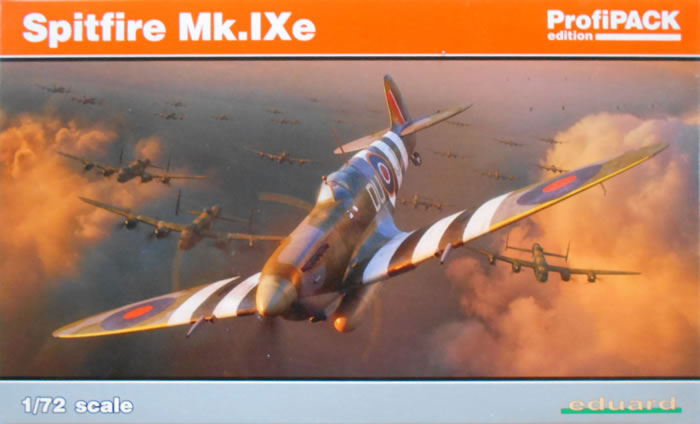
ProfiPACK Edition, 1/72 scale
S
u m m a r y |
| Catalogue Number and Price: |
Eduard Kit Nos.
70123 - Spitfire Mk.IXe ProfiPACK - USD$21.21 plus shipping
70126 - Spitfire Mk.XVIe Bubbletop ProfiPACK - USD$21.21 plus shipping
both available online from Eduard
|
| Scale: |
1/72 |
| Contents and Media: |
See descripton below |
| Review Type: |
FirstLook |
| Advantages: |
Well-moulded with plenty of options, clear instructions, good range of schemes and in these Profipack versions with PE and masks clearly the best later Spitfires around. Will enhance your spares box!. |
| Disadvantages: |
None noted. |
| Conclusion: |
Eduard has delivered a splendid pair of kits, well up to the best in the modern modelling world, and these appear to be capable of being made up into absolutely cracking little replicas by almost any standard of modeller and, in the hands of an expert, will be class winners anywhere. |
Reviewed by Graham Carter

Eduard's 1/72 scale Spitfire Mk.IXc Late Version Weekend Edition
is available online from Squadron.com
I am dealing with these two kits together as there is little difference between them apart from fuselage halves and decals. Both kits come in enormous boxes which does mean the parts have rattled around quite a bit in transit, although no damage appears to have been done as each sprue is packed in its own bag. These boxes could easily have been 2/3 the size, but are both strong and top opening. I fitted six completed 1/72 Spitfires inside the bottom of the box with plenty of room for padding.
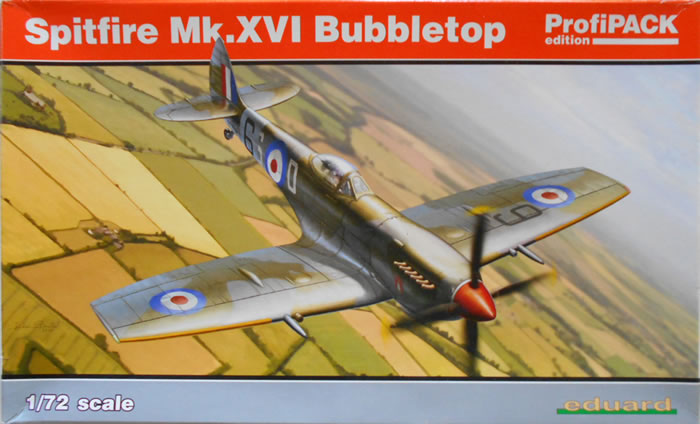
The original Eduard 1/72 Supermarine Spitfire release was in late 2016 and kitted the late version of the Mark IX. It was well-received due to its level of detail, fit and accuracy as well as the good range of schemes provided. It was followed by both a Profipack and a Weekend Edition which respectively offered more detail (in the form of masks, coloured PE and more schemes) and fewer options (only one scheme) but with the same parts. A Royal Class limited edition contained FOUR entire kits and decals for FOURTEEN different aircraft that made use of more of the optional parts with decals for LFIX and HFIX versions! This kit also contained resin wheels and beer barrels. And again later last year Eduard made further use of the sprues by issuing a Dual Combo double kit of the MkVIII, now with new resin blocky tyres and a massive decal choice, some of which were apparently incorrectly presented.
Those of you who have seen these splendid kits before will be familiar with mass of finely moulded parts (over 150 of them) including all relevant rudder shapes, wing-tips, cockpit details, tanks and weapons and the famous ‘pinwheel’ for the transparencies in different styles and catering for open and closed positions. The review kits were the Profipack versions so also contained masks for the canopies and a PE set for all the small parts such as radiator innards and coloured belts and instrument panel.
Numerous resin and PE accessory sets are available for these kits, some by Eduard themselves but quite honestly, I can’t see the need as the parts are so finely done; oh, alright, maybe the u/c doors look better in etch!
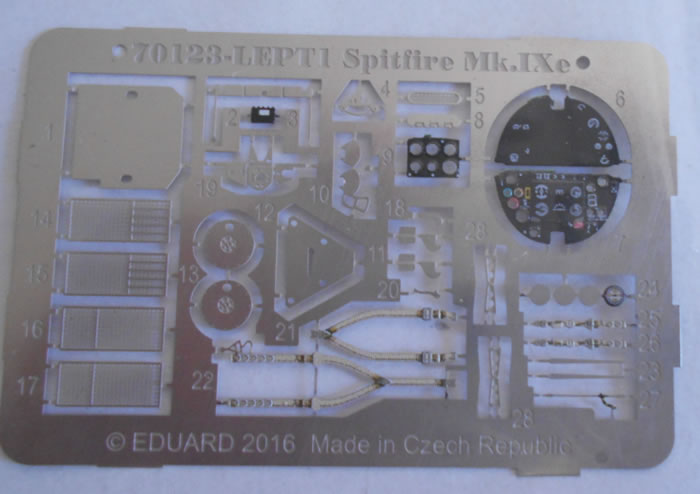
I have included images of the differing fuselage sprues as the Bubbletop obviously has the lowered rear deck. Your spares box will benefit enormously from the unused parts and this does raise the issue of the care you will need to take in sorting out exactly which parts are needed for the model you are building. Fortunately the instructions are very clear about these differences – in the Mk.XVI for example there are 64 parts indicated as not to be used! I would be very tempted to remove them from the sprues when I started to avoid future issues.

For the Mk.IXe you have 54 parts to go into the spares box. The A5 stapled instruction booklets illustrate each step with coloured line-drawings and the schemes are shown in four views and colour. Both kits include a stencil placement diagram, again in four views – very thorough.

In two of the Mk. XVI examples the modeller will need to add his/her own fine wire/HSS aerial behind the canopy.
I thought it was a good idea to do the wheels and tyres as seperate parts to both allow different hub types and to make painting easier, saves that awkward masking or hand-painting job. Undercarriage legs are also set at the correct side and forward angles to add accuracy.
Markings
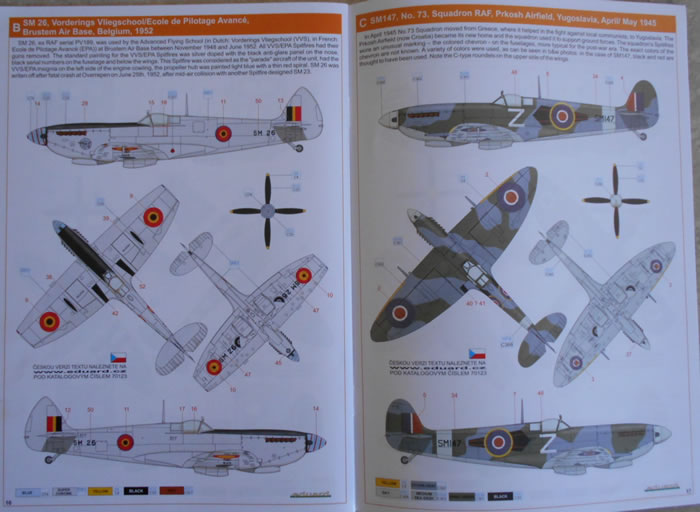
For the Mk IXe the examples provided are:-
1. Pl124 of 312 Sqn RAF in France in 1944 in Dk Green/Ocean Grey over Medium Sea Grey with B&W ID bands,
2. SM147 of 73 Sqn in Yugoslavia in 1945 in the same colours but no ID bands,
3. RK856 of 3 Sqn SAAF in 1945 , again in the same scheme as ‘2’,
4. SM26, an overall silver painted example with clipped wings from the Belgian training school, and
5. 03 of the Israeli AF in 1953 in Dk Blue/Sand over pale grey, again with clipped wings.
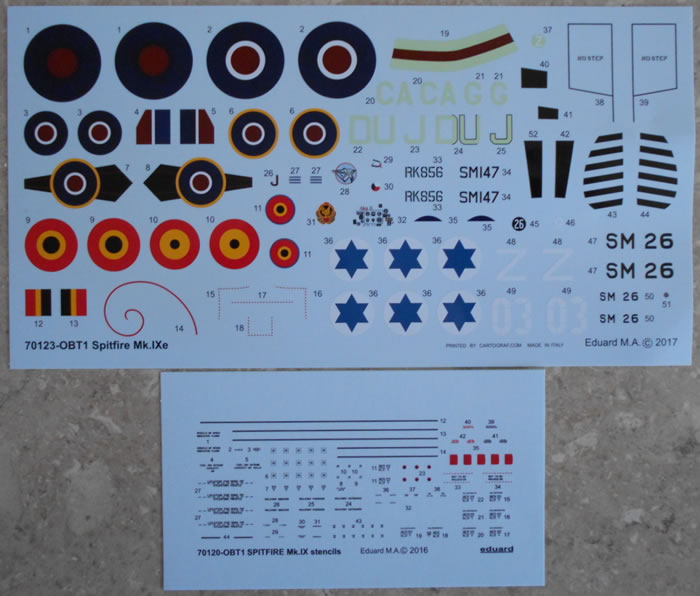
The Mk XVI choices are four with clipped wings:

1. SL718 in Dk Green/Ocean Grey/Medium Sea Grey of 612 Sqn RAuxAF Cooper Air Race, No. 6,
2. RW393, overall silver, 601 Sqn RAuxAF, Cooper Air Race No.5,
3. SL549, overall silver of 17 Sqn RAF in 1950, and
4. TE456, in Dk Green/Ocean Grey/Medium Sea Grey of 501 Sqn, 1949.
and one with full span wings,
5.SL721, the personal mount of ACM Sir James Robb, finished in o/a PRU Blue, 1951.
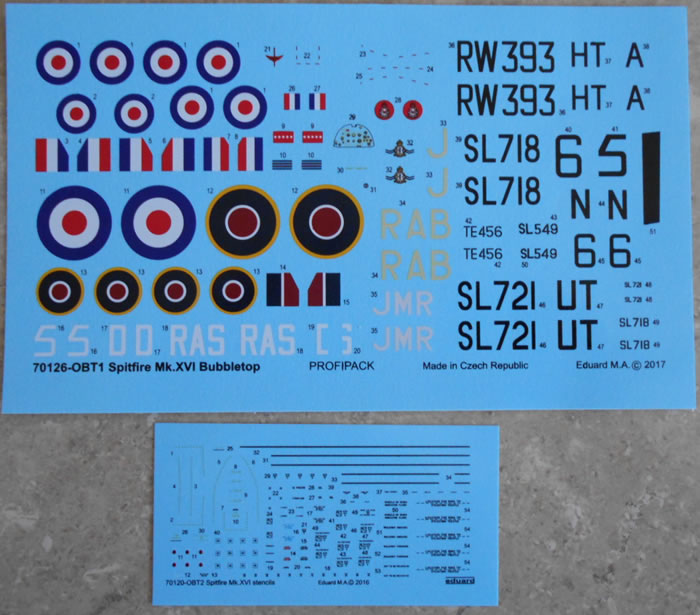
Eduard has delivered a splendid pair of kits, well up to the best in the modern modelling world, and these appear to be capable of being made up into absolutely cracking little replicas by almost any standard of modeller.
In the hands of an expert, these will be class winners anywhere.
Thanks to Eduard for the sample
Review Text Copyright © 2018 by Graham Carter
Page Created 23 April, 2018
Last updated
24 April, 2018
Back to HyperScale Main Page
Back to Reviews Page |
